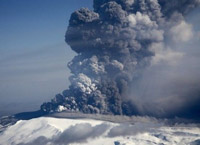 |
|
Science Underpins Ash Cloud Advice
 Eruptions from the Eyjafjallajökull volcano have continued overnight with Eyjafjallajokull continuing to emit debris to 4 to 5 km for much of the time. Eruptions from the Eyjafjallajökull volcano have continued overnight with Eyjafjallajokull continuing to emit debris to 4 to 5 km for much of the time.
Weather patterns continue to blow areas of ash towards the UK.
The Met Office uses multiple dispersion models endorsed by the International meteorological community. The output from the Met Office volcanic ash dispersion model has been compared with our neighbouring VAACs in Canada and France since the beginning of this incident and the results are consistent.
Our models are confirmed by observations which have observed ash in the UK and South of England.
- Met Office and NERC aircraft has observed volcanic ash in UK airspace at varying heights.
- Multiple land observations have recorded ash in the skies across the UK, including across Southern Britain
- Balloon observations have shown a 600m deep ash cloud at an altitude of 4km across parts of the UK.
The Met Office is the North-west European Volcanic Ash Advisory Centre with responsibility for issuing the Volcanic Ash Advisories for volcanoes erupting in this area in line with internationally agreed standards and processes. This means the Met Office's role is to support NATS, CAA and other aviation authorities decision-making.
It is for the aviation industry and regulator to set thresholds for safe ash ingestion. Currently, world-wide advice from ICAO is based on engine and airframe manufacturers stating a zero tolerance to ash ingestion. This means that aircraft should not be exposed to any volcanic ash.
As the volcanic activity changes, there may be some clearance of ash at times, over parts of the UK. We will continue to provide timely advice to NATs to help them make the most of these windows of opportunity.
The Met Office is unable to advise of any details of any flights. However, many airlines are providing information on their websites.
Source: Met Office
|
|
|
Designed, Hosted and Maintained by Union Safety Services
|